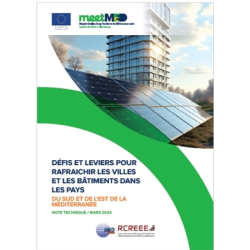Défis et leviers pour rafraîchir les villes et les bâtiments dans les pays du sud et de l'est de la Méditerranée-note technique
Etude/Recherche
Mis en ligne le : 17/02/2025


Factsheets
The Mediterranean region, with its dry, hot climate, is particularly vulnerable to increases in atmospheric temperature and is highly susceptible to heatwaves and periods of drought. IPCC scenarios predict that average maximum temperatures could reach around 46°C by 2050 and almost 50°C by the end of the century, and summer rainfall is likely to fall by 10 to 30% in some regions. Furthermore, the concentration of populations and infrastructures in urban areas makes them particularly sensitive to these hazards.
There is therefore an urgent need to work on cooling solutions at different scales, from individual buildings to entire cities, with the aim of as much as possible, improving the thermal performance of buildings and installing more efficient cooling equipment in households and public buildings.
The Mediterranean region, with its dry, hot climate, is particularly vulnerable to increases in atmospheric temperature and is highly susceptible to heatwaves and periods of drought. IPCC scenarios predict that average maximum temperatures could reach around 46°C by 2050 and almost 50°C by the end of the century, and summer rainfall is likely to fall by 10 to 30% in some regions. Furthermore, the concentration of populations and infrastructures in urban areas makes them particularly sensitive to these hazards.
There is therefore an urgent need to work on cooling solutions at different scales, from individual buildings to entire cities, with the aim of as much as possible, improving the thermal performance of buildings and installing more efficient cooling equipment in households and public buildings.
Documents associés
Etude/Recherche
Mis en ligne le : 17/02/2025

Etude/Recherche
Mis en ligne le : 17/02/2025

Etude/Recherche
Mis en ligne le : 17/02/2025

Etude/Recherche
Mis en ligne le : 17/02/2025
